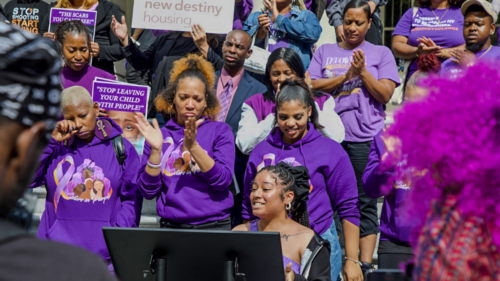To address intimate partner violence, we need to invest in stable, affordable housing.
Stable housing is the bedrock of safety. That’s especially true for people experiencing intimate partner violence, who face unique dangers in the midst of a widespread affordable housing crisis.
More than a third of domestic violence survivors are homeless at some point in their lives, and experiences of serious abuse are nearly universal among unhoused women. The lack of affordable housing often gives survivors nowhere else to go even when they feel unsafe at home, effectively forcing them to choose between housing and safety from violence. Finding another place to live is even harder for people experiencing financial abuse, which can damage someone’s credit score and leave them dependent on their partner to make ends meet.
Our RISE team, which supports community-led responses to intimate partner violence and gun violence, sees the importance of housing in their work every day. Many of the survivors our team works with are residents of New York City public housing, where limited availability and long waits for an apartment transfer—sometimes up to a year or more—can leave people stuck in dangerous living situations.
For many, the only alternative is the city’s shelter system, which includes beds specifically designated for families facing domestic violence. Yet survivors may be reluctant to leave their homes for temporary shelters, especially when that shift comes with other challenges—like a longer commute to work, transferring their children to a new school, or the risk of even more trauma. Others struggle to find a more permanent home while moving from shelter to shelter, sometimes for years on end.
Our RISE team has also seen how the lack of affordable housing can become an obstacle for people who have done harm. If someone has a restraining order against them and has to leave their household, for example, where do they go? With affordable housing in such short supply, people face much higher barriers to complying with court orders meant to keep survivors safe.
The RISE team’s role amid these complex challenges looks different from day to day as they adapt to meet the needs of the community. Much of the time, they’re responding to gaps left by systems that struggle to keep pace with the urgent needs for safety and housing felt by both survivors and their partners. In one case, the team brought a doorstop to someone who was told to wait several days for a lock replacement while they feared for their safety. On another occasion, they covered the costs of moving out for someone who was causing harm so that their partner could be safe at home.
Another way the team makes a difference is by building bridges between communities and the systems that aim to serve them and helping survivors get access to support networks. For those struggling to find a place to stay, our staff reach out to NYCHA, local domestic violence shelters, or other partners—like Safe Horizons and NYC’s Department of Youth and Community Development—to find a solution. And that goes hand in hand with their everyday work mobilizing communities across the city to put a stop to violence, and working with both survivors and people who’ve caused harm to foster healthier relationships.
Safety is often defined exclusively in terms of protection from harm and violence. But safety is much more than that: it also includes the need for job opportunities, vibrant public spaces, opportunities for healing and connection, and stable homes. To really address intimate partner violence, we need to expand our understanding of what safety means and work to increase access to stable, affordable housing for all.
